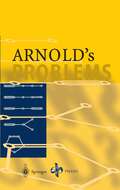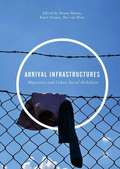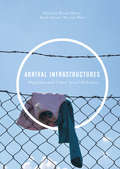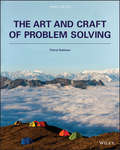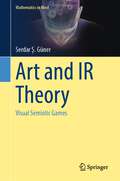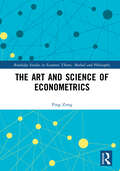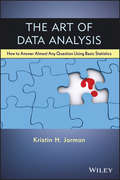- Table View
- List View
Arnold's Problems
by V. I. Arnol'DVladimir Arnold is one of the most outstanding mathematicians of our time Many of these problems are at the front line of current research
Arnon Avron on Semantics and Proof Theory of Non-Classical Logics (Outstanding Contributions to Logic #21)
by Ofer Arieli Anna ZamanskyThis book is a collection of contributions honouring Arnon Avron’s seminal work on the semantics and proof theory of non-classical logics. It includes presentations of advanced work by some of the most esteemed scholars working on semantic and proof-theoretical aspects of computer science logic. Topics in this book include frameworks for paraconsistent reasoning, foundations of relevance logics, analysis and characterizations of modal logics and fuzzy logics, hypersequent calculi and their properties, non-deterministic semantics, algebraic structures for many-valued logics, and representations of the mechanization of mathematics.Avron’s foundational and pioneering contributions have been widely acknowledged and adopted by the scientific community. His research interests are very broad, spanning over proof theory, automated reasoning, non-classical logics, foundations of mathematics, and applications of logic in computer science and artificial intelligence. This is clearly reflected by the diversity of topics discussed in the chapters included in this book, all of which directly relate to Avron’s past and present works. This book is of interest to computer scientists and scholars of formal logic.
Around and Beyond the Square of Opposition (Studies in Universal Logic)
by Jean-Yves Béziau and Dale JacquetteThe theory of oppositions based on Aristotelian foundations of logic has been pictured in a striking square diagram which can be understood and applied in many different ways having repercussions in various fields: epistemology, linguistics, mathematics, sociology, physics. The square can also be generalized in other two-dimensional or multi-dimensional objects extending in breadth and depth the original Aristotelian theory. The square of opposition from its origin in antiquity to the present day continues to exert a profound impact on the development of deductive logic. Since 10 years there is a new growing interest for the square due to recent discoveries and challenging interpretations. This book presents a collection of previously unpublished papers by high level specialists on the square from all over the world.
Around Burnside (Ergebnisse der Mathematik und ihrer Grenzgebiete. 3. Folge / A Series of Modern Surveys in Mathematics #20)
by A.I. KostrikinPerhaps it is not inappropriate for me to begin with the comment that this book has been an interesting challenge to the translator. It is most unusual, in a text of this type, in that the style is racy, with many literary allusions and witticisms: not the easiest to translate, but a source of inspiration to continue through material that could daunt by its combinatorial complexity. Moreover, there have been many changes to the text during the translating period, reflecting the ferment that the subject of the restricted Burnside problem is passing through at present. I concur with Professor Kostrikin's "Note in Proof', where he describes the book as fortunate. I would put it slightly differently: its appearance has surely been partly instrumental in inspiring much endeavour, including such things as the paper of A. I. Adian and A. A. Razborov producing the first published recursive upper bound for the order of the universal finite group B(d,p) of prime exponent (the English version contains a different treatment of this result, due to E. I. Zel'manov); M. R. Vaughan-Lee's new approach to the subject; and finally, the crowning achievement of Zel'manov in establishing RBP for all prime-power exponents, thereby (via the classification theorem for finite simple groups and Hall-Higman) settling it for all exponents. The book is encyclopaedic in its coverage of facts and problems on RBP, and will continue to have an important influence in the area.
Around the Research of Vladimir Maz'ya I: Function Spaces (International Mathematical Series #11)
by Ari LaptevThe fundamental contributions of Professor Maz'ya to the theory of function spaces and especially Sobolev spaces are well known and often play a key role in the study of different aspects of the theory, which is demonstrated, in particular, by presented new results and reviews from world-recognized specialists. Sobolev type spaces, extensions, capacities, Sobolev inequalities, pseudo-Poincare inequalities, optimal Hardy-Sobolev-Maz'ya inequalities, Maz'ya's isocapacitary inequalities in a measure-metric space setting and many other actual topics are discussed.
Around the Research of Vladimir Maz'ya II: Partial Differential Equations (International Mathematical Series #12)
by Ari LaptevTopics of this volume are close to scientific interests of Professor Maz'ya and use, directly or indirectly, the fundamental influential Maz'ya's works penetrating, in a sense, the theory of PDEs. In particular, recent advantages in the study of semilinear elliptic equations, stationary Navier-Stokes equations, the Stokes system in convex polyhedra, periodic scattering problems, problems with perturbed boundary at a conic point, singular perturbations arising in elliptic shells and other important problems in mathematical physics are presented.
Around the Research of Vladimir Maz'ya III: Analysis and Applications (International Mathematical Series #13)
by Ari LaptevThis volume reflects the variety of areas where Maz'ya's results are fundamental, influential and/or pioneering. New advantages in such areas are presented by world-recognized experts and include, in particularly, Beurling's minimum principle, inverse hyperbolic problems, degenerate oblique derivative problems, the Lp-contractivity of the generated semigroups, some class of singular integral operators, general Cwikel-Lieb-Rozenblum and Lieb-Thirring inequalities,domains with rough boundaries, integral and supremum operators, finite rank Toeplitz operators, etc.
Around the Unit Circle: Mahler Measure, Integer Matrices and Roots of Unity (Universitext)
by James McKee Chris SmythMahler measure, a height function for polynomials, is the central theme of this book. It has many interesting properties, obtained by algebraic, analytic and combinatorial methods. It is the subject of several longstanding unsolved questions, such as Lehmer’s Problem (1933) and Boyd’s Conjecture (1981). This book contains a wide range of results on Mahler measure. Some of the results are very recent, such as Dimitrov’s proof of the Schinzel–Zassenhaus Conjecture. Other known results are included with new, streamlined proofs. Robinson’s Conjectures (1965) for cyclotomic integers, and their associated Cassels height function, are also discussed, for the first time in a book.One way to study algebraic integers is to associate them with combinatorial objects, such as integer matrices. In some of these combinatorial settings the analogues of several notorious open problems have been solved, and the book sets out this recent work. Many Mahler measure results are proved for restricted sets of polynomials, such as for totally real polynomials, and reciprocal polynomials of integer symmetric as well as symmetrizable matrices. For reference, the book includes appendices providing necessary background from algebraic number theory, graph theory, and other prerequisites, along with tables of one- and two-variable integer polynomials with small Mahler measure. All theorems are well motivated and presented in an accessible way. Numerous exercises at various levels are given, including some for computer programming. A wide range of stimulating open problems is also included. At the end of each chapter there is a glossary of newly introduced concepts and definitions. Around the Unit Circle is written in a friendly, lucid, enjoyable style, without sacrificing mathematical rigour. It is intended for lecture courses at the graduate level, and will also be a valuable reference for researchers interested in Mahler measure. Essentially self-contained, this textbook should also be accessible to well-prepared upper-level undergraduates.
Around the World in 80 Games: A Mathematician Unlocks The Secrets Of The Greatest Games
by Marcus du Sautoy'Brilliantly clear and captivating prose' Stephen Fry An award-winning mathematician explores the maths behind the games we love and why we love to play them. Where should you move first in Connect 4? What is the best property in Monopoly? And how can pi help you win rock paper scissors?
Arrangements, Local Systems and Singularities: CIMPA Summer School, Galatasaray University, Istanbul, 2007 (Progress in Mathematics #283)
by Fouad El Zein Alexander I. Suciu Meral Tosun Muhammed Uludag Sergey YuzvinskyArrangements of Hyperplanes (Grundlehren der mathematischen Wissenschaften #300)
by Peter Orlik Hiroaki TeraoAn arrangement of hyperplanes is a finite collection of codimension one affine subspaces in a finite dimensional vector space. Arrangements have emerged independently as important objects in various fields of mathematics such as combinatorics, braids, configuration spaces, representation theory, reflection groups, singularity theory, and in computer science and physics. This book is the first comprehensive study of the subject. It treats arrangements with methods from combinatorics, algebra, algebraic geometry, topology, and group actions. It emphasizes general techniques which illuminate the connections among the different aspects of the subject. Its main purpose is to lay the foundations of the theory. Consequently, it is essentially self-contained and proofs are provided. Nevertheless, there are several new results here. In particular, many theorems that were previously known only for central arrangements are proved here for the first time in completegenerality. The text provides the advanced graduate student entry into a vital and active area of research. The working mathematician will findthe book useful as a source of basic results of the theory, open problems, and a comprehensive bibliography of the subject.
Arrival Infrastructures: Urban Social Mobility And Migration
by Bruno Meeus Karel Arnaut Bas Van HeurThis volume introduces a strategic interdisciplinary research agenda on arrival infrastructures. Arrival infrastructures are those parts of the urban fabric within which newcomers become entangled on arrival, and where their future local or translocal social mobilities are produced as much as negotiated. Challenging the dominance of national normativities, temporalities, and geographies of “arrival,” the authors scrutinize the position and potential of cities as transnationally embedded places of arrival. Critically interrogating conceptions of migrant arrival as oriented towards settlement and integration, the volume directs attention to much more diverse migration trajectories that shape our cities today. Each chapter examines how migrants, street-level bureaucrats, local residents, and civil society actors build—with the resources they have at hand—the infrastructures that accommodate, channel, and govern arrival.
Arrival Infrastructures: Migration and Urban Social Mobilities
by Bruno Meeus Karel Arnaut Bas Van HeurThis volume introduces a strategic interdisciplinary research agenda on arrival infrastructures. Arrival infrastructures are those parts of the urban fabric within which newcomers become entangled on arrival, and where their future local or translocal social mobilities are produced as much as negotiated. Challenging the dominance of national normativities, temporalities, and geographies of “arrival,” the authors scrutinize the position and potential of cities as transnationally embedded places of arrival. Critically interrogating conceptions of migrant arrival as oriented towards settlement and integration, the volume directs attention to much more diverse migration trajectories that shape our cities today. Each chapter examines how migrants, street-level bureaucrats, local residents, and civil society actors build—with the resources they have at hand—the infrastructures that accommodate, channel, and govern arrival.
Arrival Infrastructures (PDF): Migration and Urban Social Mobilities
by Bruno Meeus Karel Arnaut Bas Van HeurThis volume introduces a strategic interdisciplinary research agenda on arrival infrastructures. Arrival infrastructures are those parts of the urban fabric within which newcomers become entangled on arrival, and where their future local or translocal social mobilities are produced as much as negotiated. Challenging the dominance of national normativities, temporalities, and geographies of “arrival,” the authors scrutinize the position and potential of cities as transnationally embedded places of arrival. Critically interrogating conceptions of migrant arrival as oriented towards settlement and integration, the volume directs attention to much more diverse migration trajectories that shape our cities today. Each chapter examines how migrants, street-level bureaucrats, local residents, and civil society actors build—with the resources they have at hand—the infrastructures that accommodate, channel, and govern arrival.
Arrovian Aggregation Models (Theory and Decision Library B #39)
by Fuad T. AleskerovAggregation of individual opinions into a social decision is a problem widely observed in everyday life. For centuries people tried to invent the `best' aggregation rule. In 1951 young American scientist and future Nobel Prize winner Kenneth Arrow formulated the problem in an axiomatic way, i.e., he specified a set of axioms which every reasonable aggregation rule has to satisfy, and obtained that these axioms are inconsistent. This result, often called Arrow's Paradox or General Impossibility Theorem, had become a cornerstone of social choice theory. The main condition used by Arrow was his famous Independence of Irrelevant Alternatives. This very condition pre-defines the `local' treatment of the alternatives (or pairs of alternatives, or sets of alternatives, etc.) in aggregation procedures. Remaining within the framework of the axiomatic approach and based on the consideration of local rules, Arrovian Aggregation Models investigates three formulations of the aggregation problem according to the form in which the individual opinions about the alternatives are defined, as well as to the form of desired social decision. In other words, we study three aggregation models. What is common between them is that in all models some analogue of the Independence of Irrelevant Alternatives condition is used, which is why we call these models Arrovian aggregation models. Chapter 1 presents a general description of the problem of axiomatic synthesis of local rules, and introduces problem formulations for various versions of formalization of individual opinions and collective decision. Chapter 2 formalizes precisely the notion of `rationality' of individual opinions and social decision. Chapter 3 deals with the aggregation model for the case of individual opinions and social decisions formalized as binary relations. Chapter 4 deals with Functional Aggregation Rules which transform into a social choice function individual opinions defined as choice functions. Chapter 5 considers another model &endash; Social Choice Correspondences when the individual opinions are formalized as binary relations, and the collective decision is looked for as a choice function. Several new classes of rules are introduced and analyzed.
The Art and Craft of Problem Solving
by Paul ZeitzAppealing to everyone from college-level majors to independent learners, The Art and Craft of Problem Solving, 3rd Edition introduces a problem-solving approach to mathematics, as opposed to the traditional exercises approach. The goal of The Art and Craft of Problem Solving is to develop strong problem solving skills, which it achieves by encouraging students to do math rather than just study it. Paul Zeitz draws upon his experience as a coach for the international mathematics Olympiad to give students an enhanced sense of mathematics and the ability to investigate and solve problems.
Art and IR Theory: Visual Semiotic Games (Mathematics in Mind)
by Serdar Ş. GünerThis book examines the correspondence between international relations (IR) theories of structural realism and constructivism and paintings, notably the artwork of Mark Rothko and Jackson Pollock, in a game theory setting. This interdisciplinary approach, through the lens of game theory and semiotics, permits different, enriched interpretations of structural realism and constructivism. These theories constitute an axis of debate between social and systemic approaches to international politics, as well as an axis of differentiation between scientific realism and positivism as philosophies of science. As such, the interpretations explored in this book contribute to what we know about international relations, how semiotics intersect with strategic uncertainty, and explains these interactions in the proposed games model.The book’s use of game theory and semiotics generate ‘visual semiotic games’ (VSGs) that shed light on the debate axes through strategic uncertainty, interactions, and players’ interactive belief systems. VSGs will contribute to literature on experimental semiotics in the sense of players’ coordination behavior, beliefs, and artistic evaluations. The equilibria, interpreted through branches of philosophy of mind and theories of explanation, will reveal possibilities of agreement among players about which artwork representing the theory at hand is the best, opening innovative research perspectives for the discipline of IR theory.
The Art and Science of Econometrics (Routledge Studies in Economic Theory, Method and Philosophy)
by Ping ZongToday econometrics has been widely applied in the empirical study of economics. As an empirical science, econometrics uses rigorous mathematical and statistical methods for economic problems. Understanding the methodologies of both econometrics and statistics is a crucial departure for econometrics. The primary focus of this book is to provide an understanding of statistical properties behind econometric methods. Following the introduction in Chapter 1, Chapter 2 provides the methodological review of both econometrics and statistics in different periods since the 1930s. Chapters 3 and 4 explain the underlying theoretical methodologies for estimated equations in the simple regression and multiple regression models and discuss the debates about p-values in particular. This part of the book offers the reader a richer understanding of the methods of statistics behind the methodology of econometrics. Chapters 5–9 of the book are focused on the discussion of regression models using time series data, traditional causal econometric models, and the latest statistical techniques. By concentrating on dynamic structural linear models like state-space models and the Bayesian approach, the book alludes to the fact that this methodological study is not only a science but also an art. This work serves as a handy reference book for anyone interested in econometrics, particularly in relevance to students and academic and business researchers in all quantitative analysis fields.
The Art and Science of Econometrics (Routledge Studies in Economic Theory, Method and Philosophy)
by Ping ZongToday econometrics has been widely applied in the empirical study of economics. As an empirical science, econometrics uses rigorous mathematical and statistical methods for economic problems. Understanding the methodologies of both econometrics and statistics is a crucial departure for econometrics. The primary focus of this book is to provide an understanding of statistical properties behind econometric methods. Following the introduction in Chapter 1, Chapter 2 provides the methodological review of both econometrics and statistics in different periods since the 1930s. Chapters 3 and 4 explain the underlying theoretical methodologies for estimated equations in the simple regression and multiple regression models and discuss the debates about p-values in particular. This part of the book offers the reader a richer understanding of the methods of statistics behind the methodology of econometrics. Chapters 5–9 of the book are focused on the discussion of regression models using time series data, traditional causal econometric models, and the latest statistical techniques. By concentrating on dynamic structural linear models like state-space models and the Bayesian approach, the book alludes to the fact that this methodological study is not only a science but also an art. This work serves as a handy reference book for anyone interested in econometrics, particularly in relevance to students and academic and business researchers in all quantitative analysis fields.
Art Meets Mathematics in the Fourth Dimension
by Stephen Leon LipscombTo see objects that live in the fourth dimension we humans would need to add a fourth dimension to our three-dimensional vision. An example of such an object that lives in the fourth dimension is a hyper-sphere or “3-sphere.” The quest to imagine the elusive 3-sphere has deep historical roots: medieval poet Dante Alighieri used a 3-sphere to convey his allegorical vision of the Christian afterlife in his Divine Comedy. In 1917, Albert Einstein visualized the universe as a 3-sphere, describing this imagery as “the place where the reader’s imagination boggles. Nobody can imagine this thing.” Over time, however, understanding of the concept of a dimension evolved. By 2003, a researcher had successfully rendered into human vision the structure of a 4-web (think of an ever increasingly-dense spider’s web). In this text, Stephen Lipscomb takes his innovative dimension theory research a step further, using the 4-web to reveal a new partial image of a 3-sphere. Illustrations support the reader’s understanding of the mathematics behind this process. Lipscomb describes a computer program that can produce partial images of a 3-sphere and suggests methods of discerning other fourth-dimensional objects that may serve as the basis for future artwork.
The Art of Analysis
by Arthur M. LangerIn any software project the analysis stage is vital to the success of the project. This book provides a thorough introduction to analysis and where it fits into the software engineering process. The author applies his many years of experience - as both a manager of software projects and as a consultant to numerous companies - to illustrate successful techniques and identify potential pitfalls. Based on courses at Columbia University for a diverse audience of students and professionals, the author is concerned throughout to emphasise the stages of analysis and to identify many alternative modelling tools that an analyst can use. Particular emphasis is placed on joint application development and on prototyping. Readers are assumed to have a reasonable understanding of computer concepts and terminology, making this suitable for a first-level analysis course or for information systems professionals who need an in-depth understanding of the principles of the analysis and design process.
The Art of Coding: The Language of Drawing, Graphics, and Animation
by Mohammad Majid al-Rifaie Anna Ursyn Theodor WyeldAs the title suggests, this book explores the concepts of drawing, graphics and animation in the context of coding. In this endeavour, in addition to initiating the process with some historical perspectives on programming languages, it prides itself by presenting complex concepts in an easy-to-understand fashion for students, artists, hobbyists as well as those interested in computer science, computer graphics, digital media, or interdisciplinary studies. Being able to code requires abstract thinking, mathematics skills, spatial ability, logical thinking, imagination, and creativity. All these abilities can be acquired with practice, and can be mastered by practical exposure to art, music, and literature. This book discusses art, poetry and other forms of writing while pondering difficult concepts in programming; it looks at how we use our senses in the process of learning computing and programming. Features: Introduces coding in a visual way Explores the elegance behind coding and the outcome Includes types of outcomes and options for coding Covers the transition from front-of-classroom instruction to the use of online-streamed video tutorials Encourages abstract and cognitive thinking, as well as creativity The Art of Coding contains a collection of learning projects for students, instructors and teachers to select specific themes from. Problems and projects are aimed at making the learning process entertaining, while also involving social exchange and sharing. This process allows for programming to become interdisciplinary, enabling projects to be co-developed by specialists from different backgrounds, enriching the value of coding and what it can achieve. The authors of this book hail from three different continents, and have several decades of combined experience in academia, education, science and visual arts. Source Code: The source code for the book can be accessed here.
The Art of Coding: The Language of Drawing, Graphics, and Animation
by Mohammad Majid al-Rifaie Anna Ursyn Theodor WyeldAs the title suggests, this book explores the concepts of drawing, graphics and animation in the context of coding. In this endeavour, in addition to initiating the process with some historical perspectives on programming languages, it prides itself by presenting complex concepts in an easy-to-understand fashion for students, artists, hobbyists as well as those interested in computer science, computer graphics, digital media, or interdisciplinary studies. Being able to code requires abstract thinking, mathematics skills, spatial ability, logical thinking, imagination, and creativity. All these abilities can be acquired with practice, and can be mastered by practical exposure to art, music, and literature. This book discusses art, poetry and other forms of writing while pondering difficult concepts in programming; it looks at how we use our senses in the process of learning computing and programming. Features: Introduces coding in a visual way Explores the elegance behind coding and the outcome Includes types of outcomes and options for coding Covers the transition from front-of-classroom instruction to the use of online-streamed video tutorials Encourages abstract and cognitive thinking, as well as creativity The Art of Coding contains a collection of learning projects for students, instructors and teachers to select specific themes from. Problems and projects are aimed at making the learning process entertaining, while also involving social exchange and sharing. This process allows for programming to become interdisciplinary, enabling projects to be co-developed by specialists from different backgrounds, enriching the value of coding and what it can achieve. The authors of this book hail from three different continents, and have several decades of combined experience in academia, education, science and visual arts. Source Code: The source code for the book can be accessed here.
The Art of Data Analysis: How to Answer Almost Any Question Using Basic Statistics
by Kristin H. JarmanA friendly and accessible approach to applying statistics in the real world With an emphasis on critical thinking, The Art of Data Analysis: How to Answer Almost Any Question Using Basic Statistics presents fun and unique examples, guides readers through the entire data collection and analysis process, and introduces basic statistical concepts along the way. Leaving proofs and complicated mathematics behind, the author portrays the more engaging side of statistics and emphasizes its role as a problem-solving tool. In addition, light-hearted case studies illustrate the application of statistics to real data analyses, highlighting the strengths and weaknesses of commonly used techniques. Written for the growing academic and industrial population that uses statistics in everyday life, The Art of Data Analysis: How to Answer Almost Any Question Using Basic Statistics highlights important issues that often arise when collecting and sifting through data. Featured concepts include: • Descriptive statistics • Analysis of variance • Probability and sample distributions • Confidence intervals • Hypothesis tests • Regression • Statistical correlation • Data collection • Statistical analysis with graphs Fun and inviting from beginning to end, The Art of Data Analysis is an ideal book for students as well as managers and researchers in industry, medicine, or government who face statistical questions and are in need of an intuitive understanding of basic statistical reasoning.
